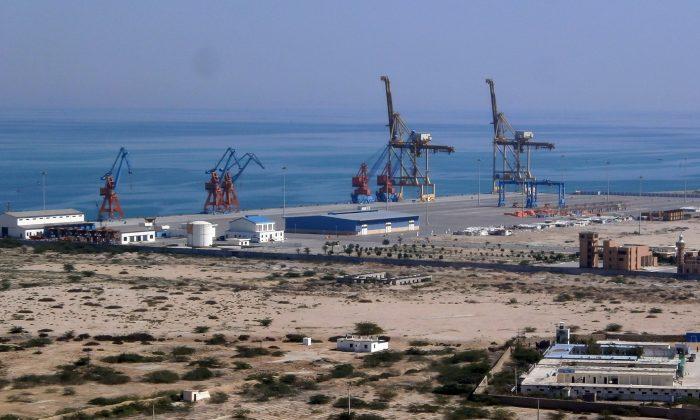The Chinese regime said it’s wrapping up its construction of artificial islands in the South China Sea, and all signs suggest its next big push will be into the Indian Ocean.
Conflicts are already surfacing. India was caught off guard in May, when the Chinese regime docked a submarine in the nearby port of Karachi in Pakistan. Close to two months later, on July 1, Chinese defense spokesman senior Col. Yang Yujin tried lightening the concern by saying the Chinese navy’s activities in the Indian Ocean are “open and transparent.”
The same day, a very different announcement was made by a senior captain from China’s National Defense University. He warned India, saying they cannot view the Indian Ocean as their backyard.
It’s unlikely the Chinese will back down, according to Richard Fisher, senior fellow with the International Assessment and Strategy Center.
“An effort to break out of the South China Sea, and then project into the Indian Ocean is one of the opening moves in China’s quest for global military and economic dominance,” Fisher said in a phone interview.
The Chinese Communist Party (CCP) is trying to build new international trade networks under its own control. Part of this will be its new Silk Road, which will include connecting China to Pakistan with roads, rails, and oil pipelines. The other side of this is its “Maritime Silk Road,” coupled with an effort to gain control or influence at all major maritime trade chokepoints.

What it’s trying to do is replicate the Pax Americana—only with a Chinese model based around selective access and strong-arming nearby countries.
The Pax Americana is the projection of U.S. military power, which secures free trade and supports a relative global peace. This includes placing military assets at all strategic sea lines of communications (SLOCs).
Experts call the Chinese version of the Pax Americana the “Pax Sinica.” To build this, the CCP plans to abandon “the traditional mentality that land outweighs sea” and begin to “protect the security of strategic SLOCs and overseas interests,” according to the Chinese military strategy white paper released on May 26.
As opposed to the U.S. system, however, the Chinese strategy is based on a version of mercantilism to control trade—as we’ve witnessed in its military push in the South China Sea, where it is beginning to deny access to other nations.
“It’s long been my conclusion that China’s ultimate goal is to become the pre-eminent global superpower, and to suppress the United States where necessary in the achievement of this goal,” Fisher said.
“China basically wants to benefit from such a pre-eminent position as has the United States for most of the period since World War II,” he said.

Because of this strategy, its version of trade requires its military to subdue everyone within its trading sphere. Its push into the Indian Ocean, coupled with land routes into Pakistan and Sri Lanka, is likewise viewed by many experts in India as a move to surround India—one of the largest competitors to the Chinese economy.
The CCP’s strategy to control maritime chokepoints is already well underway. For the outlet of the Strait of Malacca, the Chinese military has pressed into the South China Sea. For the Strait of Bab el-Mandeb, they’re planning to build a military base in Djibouti. For the Turkish Straits, they’re trying to strike deals around the new Silk Road program.
They are making similar moves at nearly every other key trade chokepoint on the map—but the Indian Ocean is a different story. They’ve already struck a 40-year deal with Pakistan to manage a port in Gwadar, and India isn’t happy with the idea of Chinese warships having a constant presence in its nearby waters.
“Gwadar, of course, is tied to parallel Pakistani and Chinese ambitions,” Fisher said, noting this ties both to Pakistan’s interest in keeping separatist factions at bay in Balochistan, where the port is located, as well as to Chinese ambitions “to make multiple access routes into the Indian Ocean.”
The Next Job
The CCP announced on June 16 that its programs to build artificial islands in the South China Sea were coming to a close. While its efforts there have continued with the construction of facilities on the fake islands, the dredgers that were once hard at work pumping sand onto reefs are now free and ready for their next job.
This is where business comes into play. The dredgers used to build China’s new artificial islands are owned by state-run companies that have stakes in the Silk Road initiative. Among these companies are the Chinese Communications Construction Company (CCCC), China Merchants Holdings (International) (CMHI), and China State Construction and Engineering Company (CSCEC).
More than half of China’s dredging capacity is controlled by CCCC, which does most of its business through an overseas subsidiary, China Harbor Engineering Company (CHEC), according to a Sept. 17 report from the U.S. Naval Institute.
It states, “As China expands into the Indian Ocean and wraps up construction in Southeast Asia,” the same types of assets it used to build islands in the South China Sea may be relocated to build ports in the Indian Ocean.
These ports, it states, would give the Chinese regime a “logistics chain for its naval activities in what its strategists term the Far Seas.”
A significant portion of the projects these companies are involved in tie directly to the its Maritime Silk Road. Among these are large-scale port projects in Pakistan’s Karachi and Gwadar—as well as in nearby Sri Lanka’s Colombo Port City, Hambantota Port, and others.
While this new effort is just starting, according to Robert Haddick, an independent contractor at U.S. Special Operations Command, it’s important to remember that most observers and analysts were caught off guard by the speed of the CCP’s construction in the South China Sea.
“You couldn’t find many analysts who could have guessed where we are today with the sand piles that China has managed to build up in the South China Sea,” Haddick said, in a phone interview. “It happened pretty suddenly and in a surprising fashion.”
“We shouldn’t close our minds to the possibility of further surprises in the Indian Ocean region also,” he said.
Surrounding the Indian Ocean
The newspaper The Namibian stirred up controversy on Nov. 19, 2014, when it published a report saying the CCP is planning to build 18 naval bases surrounding the Indian Ocean. It listed these bases in Pakistan, Sri Lanka, Burma, Djibouti, Yemen, Oman, Kenya, Tanzania, Mozambique, Seychelles, and Madagascar.
It emphasized these bases would give the Chinese navy a presence in the northern Indian Ocean, western Indian Ocean, and central south Indian Ocean.
The CCP initially denied the claims, yet in the time since the article was published, every country listed by The Namibian has moved forward with programs with the CCP, either granting it port access or working with it to construct new ports.
The Namibian’s source was a 2013 article in a Chinese state-run newspaper, the International Herald Leader, which allegedly proposed an additional 18 overseas Chinese military bases including at Pakistan’s Gwadar Port and Sri Lanka’s Port of Hambantota (Magampura Mahinda Rajapaksa Port).
The Namibian came back with another report on Jan. 20, noting that less than a week after the CCP denied the paper’s claims, the Chinese regime started moving forward with the rumored plans.
The paper published a leaked confidential letter from PLA Senior Col. Geng Yansheng, dated Dec. 22, 2014, and addressed to Namibia’s Foreign Affairs Permanent Secretary Selma Ashipala-Musavyi by Abed. The two allegedly met to discuss “several issues of mutual interest and benefit.”
The letter discussed a proposed Chinese naval base in Namibia—the likes of which Geng publicly said the PLA “currently” lacks.
The reports supported what military analysts have long suspected. In what they refer to as the “string of pearls,” they believe the Chinese regime will build a string of naval bases into the Indian Ocean, which it can use to extend its military reach.
According to Robert C. O'Brien of Real Clear Defense on March 25, the thinkers behind the CCP’s string of pearls strategy may already be eyeing the next step.
“China’s Indian Ocean-based ’string of pearls’ naval base strategy to protect the country’s 21st century vision of a ’maritime silk road‘ looks like it may now extend all the way to the South Atlantic,” O’Brien wrote.
“For India, a Chinese naval presence in nearby waters is a dawning reality,” he wrote.


![[LIVE Q&A at 10:30AM ET] Inflation Goes Down Amid Trade War; Trump Fires Back at CCP | Live With Josh](/_next/image?url=https%3A%2F%2Fimg.theepochtimes.com%2Fassets%2Fuploads%2F2025%2F04%2F10%2Fid5840055-041125_REC-1080x720.jpg&w=1200&q=75)


